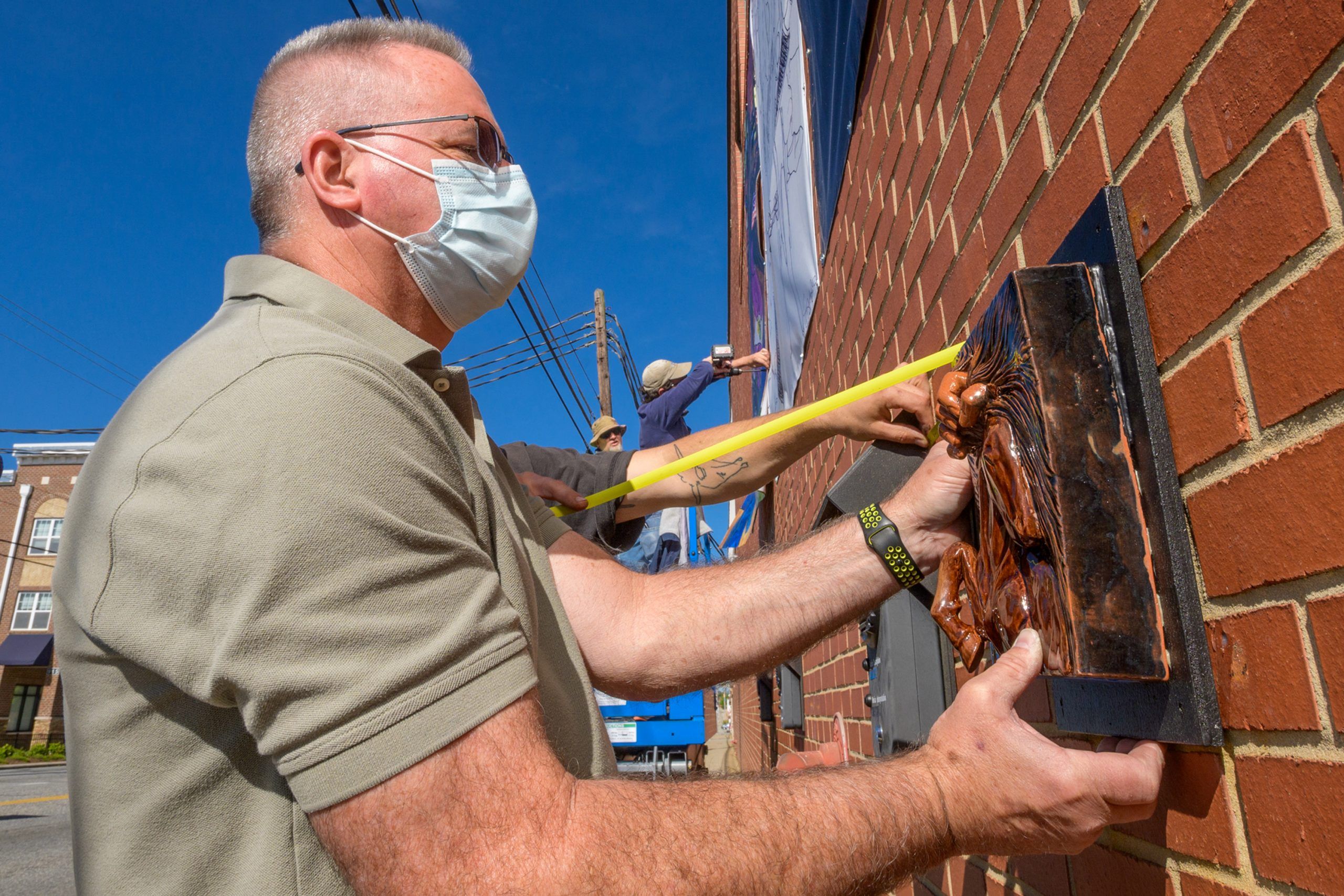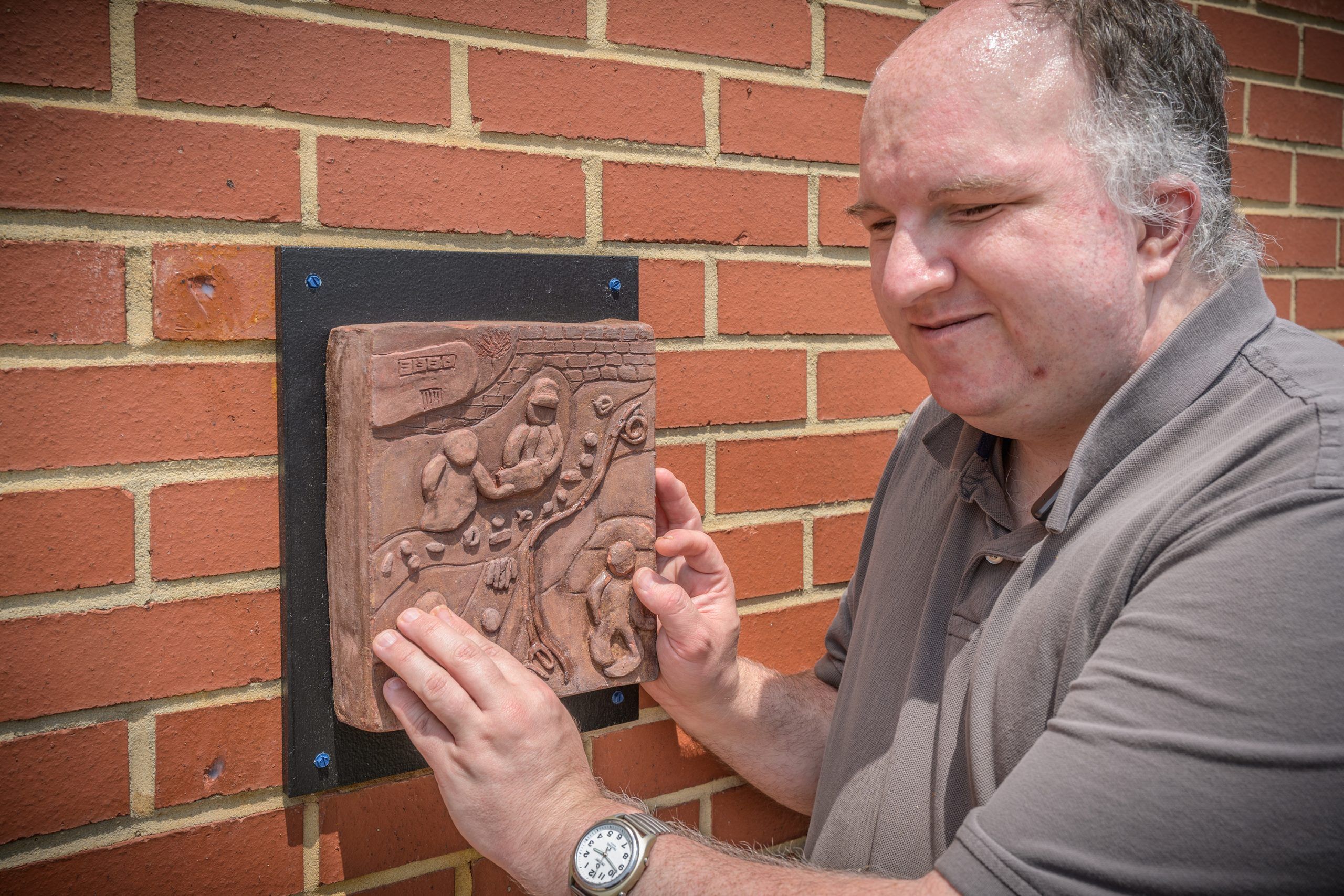What it means to be seen
The Industries of the Blind’s massive building takes up an entire city block on Gate City Boulevard but, with its nondescript brick exterior, few people noticed it there. That all changed, however, with last year’s installation of six larger-than-life paintings scrolled out across the building’s façade. The 8x10-foot banners represent a three-year collaboration between the company’s employees and UNCG students.
These paintings by students in the College of Visual and Performing Arts give insights into the triumphs and struggles of the Industries of the Blind’s employees – over half of whom are blind. “It would be easy to have a mural showing the things we manufacture here, or of somebody wearing dark sunglasses walking a path with a cane in their hand,” says Richard Oliver, the company’s director of community outreach and government relations. “But that doesn’t tell the whole story of who we are – or of the people who work here.”
The banners tell the stories of employees like Afiya Jackson, who had to fight to keep her children when authorities tried to take them away, believing blindness would prevent her from caring for them. And Tony Totten, who was born with the ability to see and hear but lost both senses over time.
“The visibility of these banners shows employees that their stories are worth being heard—and are just as valid as anyone else’s,” says Mariam Stephan, associate professor of art and painting. “The paintings are an embodiment of their successes.”
Image: Tony Totten shares his story with UNCG student Emily Jay, with assistance from an interpreter.
All hands on deck
At first, the goal was for six visual arts students to partner, one-on-one, with six employees to learn more about the employees’ life experiences and to brainstorm ways to communicate them via art – both through a painting and an accompanying audio narrative to describe the painting.
“But like any exciting project, it began to snowball,” says Adam Carlin, the college’s director of community engagement, who partnered with Oliver to bring the project to life. As the project grew, the art became a more interactive experience, and more inclusive for the people it was representing.
Soon, music students created original scores to support the paintings and the audio narratives collected by art history students. Interior architecture students designed audio boxes with two buttons so that blind or low-vision passersby can easily walk up and listen to the narratives and music. And fellow School of Arts students created touch-friendly bronze relief sculptures to accompany each painting.
Eventually, the project involved more than 100 students – a number that continued to grow this year, as creative writing students joined in to interpret a second round of 10 paintings through fiction.
Image 1: Studio art student Jordan Harp works on “The Sun All Around Me,” a collaboration with Industries of the Blind employee Danielle Woods. Image 2: Studio art student Aliyah Wilson works on an untitled painting in collaboration with IOB employee Marlon Watson.
“These students are learning a lot about the importance of making art not just for a community, but in collaboration with a community,” says Carlin. “That’s an important part of community engagement, which is vital to our college’s identity.”
Stephan adds that the project raised the bar for how her students approach painting. “They had to think differently about the visual language in general,” she says. “You can’t make a literal picture of what it means to feel a cool breeze on your face. You have to learn how to incorporate non-visual experiences.”
When she began to partner with Mary Martinez, a third-year art student, Afiya Jackson didn’t know what to expect. She couldn’t have imagined the final painting – an image of Jackson walking down a New Orleans street with her son and daughter. “We discussed colors, different shapes, and how I see things in a different way – not being able to visually see objects,” says Jackson. “We had conversations about my life and how I live independently, as well as how I can travel alone and with my small kids. I’m able to live my life as independently as anyone else in the community.”
Images: Tanessa Brown, Anthony Johnson, and AJ Inglesby explore the audio and ceramic installations based on their stories.
Stories Behind the Paintings
On his desk, Oliver maintains a growing list of employees eager to be represented in future rounds of paintings. For these employees, the opportunity to feel seen and heard is irresistible. “I’m sure this happens to people with many disabilities, but it’s tough being out in public,” says Oliver, who is legally blind and has worked with the Industries of the Blind for 25 years. “You’re at a restaurant with someone who isn’t blind, and the waitstaff speaks to the person you’re with rather than you to see what you want.”
That perception of helplessness is amplified by popular media. “A lot of times in TV and movies, blind guys are helpless. But that’s not who we are. People here are truly independent and self-sustaining,” he says. “They are building careers to provide for their families and send their kids to college. That is the journey that UNCG is helping us to share.”
UNCG’s Green Fund, a student-led and student-funded campus-based program that offers opportunities to students and employees to forward UNCG’s sustainability mission, partially funded the project. The fund’s committee said it was drawn to its “synergistic connections to the environment, economics, aesthetics, and social equity.” Support also came from a UNCG community-engaged scholarship grant.
Oliver hopes people driving by will be struck by the banners. He wants them to park in the Industries of the Blind’s parking lot, get out of their cars, and go press every button so they can really get to know the stories behind the paintings.
“We are all in the world together striving to make it a better place for each other,” Jackson says. “My goal is to educate as many people as possible about blindness and to let them know that we live the same way they live – just a little bit differently.”
Image below: The team installs pieces developed in the second year of the project. Below (l-r): Richard Oliver, Mike Jumpe and David Alcon from UNCG Facilities, Kenny Weadon and Jack Permar from the Industries of the Blind, and Dane Winkler and Adam Carlin from the UNCG College of Visual and Performing Arts.










